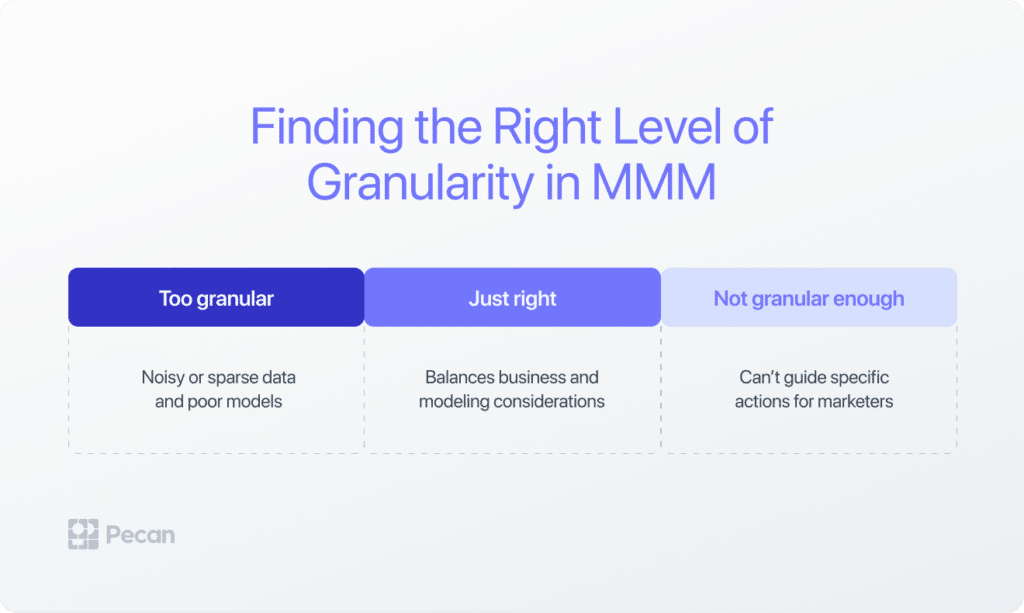- In a nutshell:Marketing mix modeling (MMM) is a powerful tool for data-driven decision-making in marketing.
- MMM helps guide budget allocation and optimize resource allocation for maximum results.
- However, MMM has limitations and challenges that need to be managed, such as granularity, connecting results to the real world, and enriching the model with appropriate data.
- Collaborating with a trusted partner is crucial for leveraging the true potential of MMM and making well-informed decisions, guided by accurate models.
It’s all about data-driven decision-making, right? That buzzword has been around for some time now. And yet, despite marketers’ best efforts, plenty of decisions — major and minor — are made daily based on gut intuition and best guesses. One formidable tool for guiding truly data-driven decisions in marketing is marketing mix modeling or MMM. MMM has regained popularity in recent years as machine learning innovations have made its usage far faster and more accessible than ever. Changes in privacy policies and customer-level data availability have also driven this method’s renaissance. And, of course, marketers themselves are in need of solutions: A Gartner survey conducted in August 2021 discovered that 59% of CMOs experienced heightened pressure from their CEOs to demonstrate the value of marketing, while 45% felt a greater sense of urgency from their CFOs. Google Trends shows the growth in interest over just the past year:
Marketing mix modeling reveals how spending in different marketing channels contributes to business outcomes, such as sales or customer inquiries. The model can also be used to simulate the results of future budget possibilities, aiding marketers in fine-tuning their budget allocation to get exactly the results they need with the available resources. While MMM is a powerful tool for these tasks, it has nuances and caveats worth recognizing. These limitations can certainly be managed, but being aware of these challenges is important as you set out to harness the true capabilities of marketing mix modeling and make informed decisions.
Where MMM Rocks
Marketing mix modeling (MMM) empowers marketers with a robust toolkit to address critical challenges and make well-informed decisions. One of its key strengths lies in guiding budget allocation. Whether you’re seeking to maximize quantity-based targets such as user installs or revenue-related goals tied to customer lifetime value (LTV), MMM offers guidance on optimizing marketing budget allocations. Imagine having a stack of money burning a hole in your pocket, but feeling unsure where to invest it effectively. On the flip side, imagine you had your stack of money reduced by half and now face working with less – but need to accomplish the same goals. Enter MMM, your trusty advisor, providing valuable insights by evaluating the effectiveness of different marketing channels. By analyzing historical data and considering metrics like user installs or customer lifetime value (LTV), MMM helps you allocate your resources wisely. When it comes to resource allocation, MMM presents three strategic choices that pack a punch. First, if you have that healthy stack of cash, you can increase your budget while minimizing the impact on efficiency. It’s like supercharging your growth without compromising the effectiveness of your existing efforts. Alternatively, if you’re facing a smaller budget, you can use MMM to maximize efficiency. Think of it as streamlining your campaigns to get the most bang for your buck. Last but not least, you can maintain your budget while increasing efficiency. MMM helps you uncover opportunities to optimize your marketing mix and make every dollar count.
By leveraging insights derived from MMM, marketers can navigate the complexities of resource allocation and make strategic decisions tailored to their unique goals. That’s an amazing capability — but it does come with some limitations. Let’s touch on those next and then explore how we can navigate them.Where MMM Needs Expert Guidance
There are three main areas where marketers wanting to use MMM effectively will need to dig into the modeling process more deeply (or, may we suggest, seek expert guidance). Perfecting the level of granularity, connecting results to the real world, and enriching data appropriately are all potential landmines in the MMM process that you should know about. But once you know they’re there — or if you’re undertaking the process with expert help — they’re very manageable.
Perfecting MMM Granularity
One challenge in using MMM effectively is finding just the right level of granularity. Ultimately, we have to find the sweet spot between modeling considerations and business considerations when it comes to aggregating marketing channels. The more granular the solution, the more actionable it can be, since marketers can use highly specific information to guide their decisions. But it’s a Goldilocks problem: one solution may be too granular, another not granular enough. What would “too granular” look like? From a budgeting point of view, it would be great to know the effectiveness of every single campaign. But in reality, campaigns often only run for very short periods of time, and each generates a relatively small amount of data. Training a model on that data would probably result in an over- or under-fitted model. To be a little less granular, a typical MMM solution would aggregate campaigns into channels — all the Facebook campaigns, all the TikTok campaigns, and so forth. For many MMM users, that provides a solid foundation of information for budget decisions, balancing the need for some specificity with the ability to create a trustworthy model. However, some MMM customers find that even channel-level groupings are too granular, for a variety of reasons. For example, maybe some channels don’t get used often and so provide very sparse data and limited information. Different groupings might be needed in this situation. Similarly, analyzing marketing channels’ effectiveness in individual cities could be excessively granular. If a channel is used in hundreds of cities, the data would be noisy and not well suited for modeling. Sure, it would be nice to be able to have city-level information for marketing decisions in order to create highly targeted campaigns, and this level of granularity might be tempting. In the end, though, this approach wouldn’t provide good results.
Achieving an accurate and practical model requires a thoughtful evaluation of granularity. The goal is to capture the essence of channel dynamics while maintaining the necessary level of simplicity for effective decision-making. It’s a delicate dance, to be sure, when you’re seeking the right level of granularity to ensure both accuracy and practical utility.Connecting MMM Results to the Real World
Tying MMM solutions to the real world can also pose challenges, primarily due to the characteristics of different marketing channels. Sparse channels with low entropy or channels with numerous outliers can complicate the modeling process. In these cases, an accurate model may struggle to find the appropriate signal from the channel, leading to issues of overlearning or underlearning. This can result in a miscalibration between this specific channel and others within the model. Whatever the situation, it’s crucial to ensure that the MMM solution effectively captures the nuances of each channel — but also avoids distortions that impact the model’s overall calibration and accuracy. Adapting the model carefully may be necessary to address these challenges and bridge the gap between the complexity of real-world channels and the requirements of a reliable MMM solution.
Enriching the Model with Appropriate Data
Incorporating enrichment features, such as seasonality, into MMM can add a fascinating layer of complexity. These enrichments often provide valuable insights into the dynamics of the marketing landscape. However, with enrichments like these, there’s a risk of overpowering the model and causing it to rely heavily on the enrichments rather than on the marketing budget itself. The marketing budget becomes what’s called a weak predictor — when in fact it needs to play a substantial role in the model’s ultimate outputs. Ideally, MMM effectively incorporates enrichment features while maintaining a strong focus on the marketing budget as a key driver. This balance will enable marketers to leverage the power of both enrichment insights and budget allocation for accurate and actionable decision-making.
How Pecan Navigates These MMM Challenges
Because we’ve developed MMM solutions for a variety of customers in different industries, we at Pecan are very aware of these challenges and have developed ways to work with and around them. It’s still absolutely possible to create accurate, trustworthy models that marketers can use to guide decisions confidently, leaving those gut-based choices behind. There are still additional nuances we continue to encounter that can complicate the process, but we collaborate closely with customers to successfully account for them:
- Understanding deterministic relationships. One challenge lies in the deterministic relationship between the target and certain features. For instance, when partners are paid per unit of the target, this relationship can influence decision-making and require careful consideration to ensure accurate modeling and effective resource allocation.
- Capturing the known unknowns. Another challenge arises from known features that prove elusive to capture, such as the impact of creative elements. Factors like color choice or other intangible aspects can significantly influence the effectiveness of an advertisement, even if it comes at a lower cost. Finding ways to incorporate these nuances into the modeling process is vital for a comprehensive understanding of the marketing landscape.
- Disentangling the effects of decisions. The marketing team’s own decisions can introduce confounding factors into the data. For example, improved campaign optimization techniques may enhance user acquisition even without a budget increase. Identifying and accounting for these influences is essential to accurately identify the impact of different factors and avoid misinterpreting results.
Addressing these challenges requires a thoughtful approach, combining domain knowledge, advanced modeling techniques, and a deep understanding of the specific context. But these aren’t obstacles to success by any means! These concerns simply accentuate that MMM truly shines when coupled with the expertise of a trusted partner who can navigate the inherent challenges and offer innovative solutions tailored to your specific needs. MMM is absolutely an investment worth making, but it requires more than a one-size-fits-all approach. A cookie-cutter method like simply applying the basics of an open-source package won’t provide reliable, useful results. To achieve optimal results, it’s crucial to collaborate with a partner who understands the intricacies of your business, can capture the deterministic relationships, account for elusive features like creative elements, and consider company-specific considerations that may impact the data. By leveraging such expertise, you can unlock the true potential of MMM and make well-informed decisions that drive serious marketing impact. Ready to learn more about Pecan's marketing mix modeling techniques and how they can solve your business challenges? Get in touch now.







